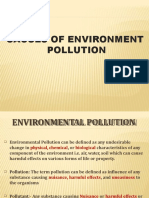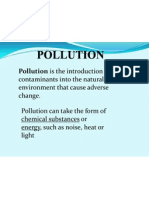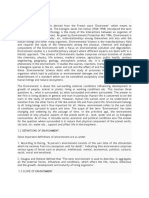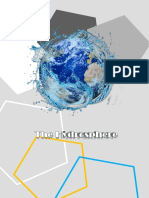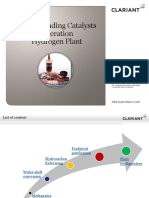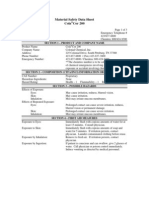Biogeochemical Cycles
Biogeochemical Cycles
Uploaded by
Abi Diciembre BrionesCopyright:
Available Formats
Biogeochemical Cycles
Biogeochemical Cycles
Uploaded by
Abi Diciembre BrionesOriginal Description:
Copyright
Available Formats
Share this document
Did you find this document useful?
Is this content inappropriate?
Copyright:
Available Formats
Biogeochemical Cycles
Biogeochemical Cycles
Uploaded by
Abi Diciembre BrionesCopyright:
Available Formats
BLESSELLE JOY D.
ORO BTM33 BIOGEOCHEMICAL CYCLES CARBON CYCLE
November 22, 2013
Plants take in carbon dioxide for photosynthesis. Animals consume plants or other animals, and all living things contain carbon. Carbon is what makes organic molecules organic. Carbon is necessary for the creation of molecules such as carbohydrates, proteins, and fats. Plants release carbon dioxide when they decompose. Animals release carbon dioxide when they decompose or respire. Carbon dioxide also is released when organic matter such as wood, leaves, coal, or oil are burned. The carbon dioxide returns to the atmosphere, where it can be taken in by more plants that are then consumed by animals. Decomposing animals and plants leach carbon into the ground, forming fossil fuels such as coal or oil. Peat also forms from the decomposition of organic matter. Some carbon is stored in the form of cellulose in the wood of trees and bushes. Facts: - Carbon (C) enters the biosphere during photosynthesis: - CO2 + H2O ---> C6H12O6 + O2 + H2O - Carbon is returned to the biosphere in cellular respiration: - O2 +H2O + C6H12O6 ---> CO2 +H2O + energy NITROGEN CYCLE Because amino acids build proteins, nitrogen is pretty important. Nitrogen also is present in the nucleic acids DNA and RNA. Life could not go on without nitrogen. The nitrogen cycle is the most complex biogeochemical cycle because nitrogen can exist in several different forms. Nitrogen fixation, nitrification, denitrification, and ammonification are all parts of the nitrogen cycle. Facts: - Nitrogen (N) is an essential constituent of protein, DNA, RNA, and chlorophyll. - N is the most abundant gas in the atmosphere, but it must be fixed or converted into a usable form. OXYGEN CYCLE As a constituent of CO2 it circulates freely throughout the biosphere. Some CO2 combines with Ca to form carbonates. O2 combines with nitrogen compounds to form nitrates. O2 combines with iron compounds to form ferric oxides. It includes photosynthesis and respiration. O2 in the troposphere is reduced to O3. Ground level O3 is a pollutant which damages lungs. Facts: - photo disassociation of H2O vapour - photosynthesis PHOSPHORUS CYCLE ATP, that ubiquitous energy molecule created by every living thing, needs phosphorus. You can tell that by its name; triphosphate indicates that it contains three molecules of phosphate, which requires phosphorus. DNA and RNA, the genetic molecules present in every living thing, have phosphate bonds holding them together, so they require phosphorus, too, as does bone tissue. Plants absorb inorganic phosphate from the soil. When animals consume plants or other animals, they acquire the phosphorus that was present in their meal. Phosphorus is excreted through the
waste products created by animals, and it is released by decomposing plants and animals. When phosphorus gets returned to the soil, it can be absorbed again by plants, or it becomes part of the sediment layers that eventually form rocks. As rocks erode by the action of water, phosphorus is returned to water and soil. Facts: - Component of DNA, RNA, ATP, proteins and enzymes - Cycles in a sedimentary cycle - A good example of how a mineral element becomes part of an organism. - The source of Phosphorus (P) is rock. - It is soluble in H2O as phosphate (PO4) SULFUR CYCLE Sulfur is released into the atmosphere through the burning of fossil fuels --especially high sulfur coal--and is a primary constituent of acid rain. Sulfuric acid is the primary constituent of acid in about all regions other than California. Sulfur dioxide and carbonyl sulfide occur in small quantities in the atmosphere; but due to its high reactivity, sulfur is quickly deposited as compound (sulfates) on land and other surfaces. Facts: - Component of protein - Cycles in both a gas and sedimentary cycle. - The source of Sulfur is the lithosphere - H2S is immediately oxidized to sulfur dioxide - SO2 and water vapor makes H2SO4, which is then carried to Earth in rainfall. - Sulfur in soluble form is taken up by plant roots and incorporated into amino acids such as cysteine. It then travels through the food chain and is eventually released through decomposition. ROCK CYCLE Igneous rock can change into sedimentary rock or into metamorphic rock. Sedimentary rock can change into metamorphic rock or into igneous rock. Metamorphic rock can change into igneous or sedimentary rock.
REFERENCES: http://www.cotf.edu/ete/modules/msese/earthsysflr/rock.html http://extension.usu.edu/waterquality/htm/educator-resources/lessonplans/wc/ http://telstar.ote.cmu.edu/environ/m3/s4/cycleSulfur.shtml http://classes.geology.illinois.edu/05SprgClass/geo497/Class%204/phosphorus.htm http://bioh.wikispaces.com/More+Elemental+Cycles http://www.physicalgeography.net/fundamentals/9r.html http://telstar.ote.cmu.edu/environ/m3/s4/cycleOxygen.shtml https://files.nyu.edu/pet205/public/biogeochem1.html http://telstar.ote.cmu.edu/environ/m3/s4/cycleSulfur.shtml http://www.dummies.com/how-to/content/discovering-the-biogeochemical-cycles.html
You might also like
- EN Water Treatment DR JuhnkeDocument11 pagesEN Water Treatment DR JuhnkeChwiha LakkNo ratings yet
- EO Technology OverviewDocument23 pagesEO Technology OverviewSoumitra DeshmukhNo ratings yet
- Lesson Plan - Oxygen-Carbon CycleDocument4 pagesLesson Plan - Oxygen-Carbon CycleHazael Jane Balais100% (3)
- Biogeochemical CyclesDocument25 pagesBiogeochemical CyclesAlokfriNo ratings yet
- Carboxylic Acids (MRH)Document49 pagesCarboxylic Acids (MRH)Ali Akand AsifNo ratings yet
- Factors That Influence Biogeochemical CyclesDocument1 pageFactors That Influence Biogeochemical CyclesLara Gatbonton100% (3)
- Bryophytes PDFDocument7 pagesBryophytes PDFPoohooNo ratings yet
- Types of BiomeDocument8 pagesTypes of Biomelizzie_mcgNo ratings yet
- DRM (Natural and Anthropogenic HazardsDocument47 pagesDRM (Natural and Anthropogenic HazardsTamia ShoaibNo ratings yet
- StratigrafiDocument22 pagesStratigrafiAdityaMangalaNo ratings yet
- Climate Change Impacts On Biodiversity-The Setting of A Lingering Global CrisisDocument10 pagesClimate Change Impacts On Biodiversity-The Setting of A Lingering Global CrisisRin FitriaNo ratings yet
- THE Biosphere and Its Natural ResourcesDocument28 pagesTHE Biosphere and Its Natural ResourcesDoods GaldoNo ratings yet
- The Climate System: An Overview: Co-Ordinating Lead AuthorDocument14 pagesThe Climate System: An Overview: Co-Ordinating Lead AuthorAlina SurubaruNo ratings yet
- Global EcologyDocument5 pagesGlobal EcologyLonnie AsisNo ratings yet
- TRANSPIRATIONDocument20 pagesTRANSPIRATIONMelanie LaureanoNo ratings yet
- Environmental Pollution 2Document23 pagesEnvironmental Pollution 2Dulon ChakrabortyNo ratings yet
- PollutionDocument13 pagesPollutionRahul VatsNo ratings yet
- Lake StratificationDocument3 pagesLake Stratificationsagar dasguptaNo ratings yet
- Carboxylic AcidDocument21 pagesCarboxylic AcidShalsabila NHNo ratings yet
- Lake StratificationDocument8 pagesLake StratificationJudelle Enriquez-GazaNo ratings yet
- 6 HydrosphereDocument11 pages6 HydrosphereAndrew GravesNo ratings yet
- Project Global WarmingDocument3 pagesProject Global Warmingdiotima hazra100% (9)
- Biodiversity & Its TypesDocument9 pagesBiodiversity & Its Typesakhileshmoney73% (11)
- ECOSYSTEM G6 RubillanewDocument12 pagesECOSYSTEM G6 RubillanewAh RainNo ratings yet
- Lake Morphometry: Shape and Size of Lake InfluencesDocument5 pagesLake Morphometry: Shape and Size of Lake InfluencesReinaur Signey AluningNo ratings yet
- Law of The Limiting FactorsDocument4 pagesLaw of The Limiting FactorsBiswajit DarbarNo ratings yet
- Grassland EcosystemDocument15 pagesGrassland EcosystemHarsh BansalNo ratings yet
- Ocean and ClimateDocument18 pagesOcean and ClimateSiti hawaNo ratings yet
- Biogeochemical Cycle: Environmental CyclesDocument21 pagesBiogeochemical Cycle: Environmental CyclesAhmad Sharief Bin JaylaniNo ratings yet
- Difference Between Cold-Blooded and Warm-Blooded AnimalsDocument5 pagesDifference Between Cold-Blooded and Warm-Blooded AnimalsShakil AhmedNo ratings yet
- PollutionDocument29 pagesPollutionPratham PatelNo ratings yet
- 14.1 Properties of Acids and BasesDocument12 pages14.1 Properties of Acids and Basesapi-3863745No ratings yet
- 03 BiosphereDocument37 pages03 BiosphereRonel A GaviolaNo ratings yet
- 3.1 Introduction To BiodiversityDocument14 pages3.1 Introduction To Biodiversityvandana dharraNo ratings yet
- Chemical Thermodynamics HandoutDocument8 pagesChemical Thermodynamics HandoutKyle Cedric MitalNo ratings yet
- Unit 2 - PollutionDocument232 pagesUnit 2 - PollutionHariharan MNo ratings yet
- Sulfur CycleDocument14 pagesSulfur CycleMeyrina PronityastutiNo ratings yet
- Nutrient CyclesDocument29 pagesNutrient CyclesMajid KhanNo ratings yet
- Chapter 1-Introduction To Ecological PrinciplesDocument49 pagesChapter 1-Introduction To Ecological PrinciplesMuhammad DanialNo ratings yet
- Introduction To Earth ScienceDocument62 pagesIntroduction To Earth SciencePrincess CuevaNo ratings yet
- EutrophicationDocument32 pagesEutrophicationJose Maria De Viana100% (1)
- Sources of Greenhouse GasesDocument4 pagesSources of Greenhouse GasesAkil Goboc IndatuanNo ratings yet
- Climate ChangeDocument19 pagesClimate ChangeReenald SapicoNo ratings yet
- Plant Water RelationsDocument27 pagesPlant Water RelationsNam GonzalesNo ratings yet
- EVS CHAP 2 EcosystemDocument105 pagesEVS CHAP 2 EcosystemNida KhanNo ratings yet
- Water Pollution Essay - Essay On Water Pollution, Effects, Causes, SourcesDocument3 pagesWater Pollution Essay - Essay On Water Pollution, Effects, Causes, SourcesshettyNo ratings yet
- Aquatic EcosystemDocument10 pagesAquatic EcosystemNooril MoujudhuNo ratings yet
- The Planet EarthDocument62 pagesThe Planet EarthJohn OsborneNo ratings yet
- Measuring Biodiversity: See The Associated Lesson Plan atDocument17 pagesMeasuring Biodiversity: See The Associated Lesson Plan atapi-243961057No ratings yet
- Lec 2 - Types of Pollution and PollutantsDocument31 pagesLec 2 - Types of Pollution and PollutantsmianaliarbiNo ratings yet
- Nupur Dagdiya - Water Pollution class-IXDocument28 pagesNupur Dagdiya - Water Pollution class-IXNupur DagdiyaNo ratings yet
- 12 Population BiologyDocument22 pages12 Population Biologyजलन्धर100% (1)
- Solid Waste Management New PDFDocument3 pagesSolid Waste Management New PDFraja velNo ratings yet
- Plant Transport To WriteDocument17 pagesPlant Transport To WritelaibahundekarNo ratings yet
- Photosynthesis LECTUREDocument36 pagesPhotosynthesis LECTUREAnonymous HXLczq3100% (1)
- Biomes Kinds of EcosystemDocument4 pagesBiomes Kinds of EcosystemDesiree G. SacasanNo ratings yet
- Atmospheric MoistureDocument25 pagesAtmospheric MoistureClaudyo A Lerry Mande100% (1)
- Environmental Law AssignmentDocument4 pagesEnvironmental Law AssignmentBO-Manipur NHIDCLNo ratings yet
- Advantages of Fossil FuelsDocument3 pagesAdvantages of Fossil FuelsyolymonjalopezNo ratings yet
- The HydrosphereDocument14 pagesThe HydrosphereEstela Garcia AnayaNo ratings yet
- Global Warming IntroductionDocument7 pagesGlobal Warming IntroductionAlex100% (39)
- Chapter 1: Hydrology and Hydrologic CycleDocument13 pagesChapter 1: Hydrology and Hydrologic CycledadaNo ratings yet
- Nutrient CyclesDocument2 pagesNutrient CyclesKumail AliNo ratings yet
- Letter For Brgy 700 721Document22 pagesLetter For Brgy 700 721Abi Diciembre BrionesNo ratings yet
- Titration of Amino Acids and PeptidesDocument2 pagesTitration of Amino Acids and PeptidesAbi Diciembre Briones100% (1)
- Auscultatory Method: Group 2: Briones, Botones, CabadingDocument15 pagesAuscultatory Method: Group 2: Briones, Botones, CabadingAbi Diciembre BrionesNo ratings yet
- Structural Staining Techniques: Activity 2Document11 pagesStructural Staining Techniques: Activity 2Abi Diciembre BrionesNo ratings yet
- Group 5 Elga Output in Med para Lab and LecDocument2 pagesGroup 5 Elga Output in Med para Lab and LecAbi Diciembre BrionesNo ratings yet
- Diagnostic Feature of EncystmentDocument2 pagesDiagnostic Feature of EncystmentAbi Diciembre BrionesNo ratings yet
- Classification of Hotels in The PhilippinesDocument4 pagesClassification of Hotels in The PhilippinesAbi Diciembre BrionesNo ratings yet
- SeretideDocument5 pagesSeretideAbi Diciembre BrionesNo ratings yet
- Test UploadDocument8 pagesTest UploadAbi Diciembre BrionesNo ratings yet
- Thesis On Pre - Marital Sex.Document49 pagesThesis On Pre - Marital Sex.Charmaine Inah Abas Calumpang92% (145)
- Nervous Tissues: Abigail Loren D. Briones HUB34Document9 pagesNervous Tissues: Abigail Loren D. Briones HUB34Abi Diciembre BrionesNo ratings yet
- REED143 - Living Out Our Christian CommitmentDocument6 pagesREED143 - Living Out Our Christian CommitmentAbi Diciembre BrionesNo ratings yet
- UnderstandingCatalystsOperation H2plantcomplete Nov2015Document141 pagesUnderstandingCatalystsOperation H2plantcomplete Nov2015Mie GranatNo ratings yet
- Climate Change Powerpoint PresentationDocument26 pagesClimate Change Powerpoint PresentationAdelita Morales Gomba100% (1)
- SOAL B Inggris Kls XI GanjilDocument8 pagesSOAL B Inggris Kls XI Ganjiladam authoraNo ratings yet
- Breathing and Gas Exchange PowerpointDocument53 pagesBreathing and Gas Exchange Powerpointapi-263357086100% (1)
- 2013 - Cambridge As and A Level Thining Skill - 9694 - s13!1!11Document20 pages2013 - Cambridge As and A Level Thining Skill - 9694 - s13!1!11BOOKh333No ratings yet
- Aerated LagoonsDocument10 pagesAerated Lagoonsnp27031990No ratings yet
- Cryogenic CoolingDocument16 pagesCryogenic CoolingGissmoNo ratings yet
- Ce51 Chess Web Final July 08Document15 pagesCe51 Chess Web Final July 08bendeniNo ratings yet
- MSDS Colacor 200Document3 pagesMSDS Colacor 200mndmattNo ratings yet
- Unit 12 Human PopulationDocument20 pagesUnit 12 Human Populationclaud doctoNo ratings yet
- ThesisDocument88 pagesThesissiddharth18No ratings yet
- Carbon Cycle WorksheetDocument2 pagesCarbon Cycle WorksheetSanaa SamkoNo ratings yet
- Material Safety Data Sheet: Section 1. Chemical Product and Company IdentificationDocument6 pagesMaterial Safety Data Sheet: Section 1. Chemical Product and Company IdentificationMarco CulquiNo ratings yet
- Dowex Ion Exchange Resins Water Conditioning Manual L PDFDocument93 pagesDowex Ion Exchange Resins Water Conditioning Manual L PDFRizkaLestariNo ratings yet
- Gbhe Ammonia Co2 Removal Systems WSV PDFDocument20 pagesGbhe Ammonia Co2 Removal Systems WSV PDFAaserElkenanyNo ratings yet
- Safety Data SheetDocument19 pagesSafety Data SheetUtibe EdemNo ratings yet
- Review of LiteratureDocument22 pagesReview of Literaturejavedsaqi64% (11)
- Simulation of Supercritical Water Gasification of Biomass by Aspenplus®Document15 pagesSimulation of Supercritical Water Gasification of Biomass by Aspenplus®salehmashrur 98No ratings yet
- 2004 Chemistry - James Ruse With SolutionsDocument36 pages2004 Chemistry - James Ruse With SolutionsWilliam HouNo ratings yet
- Presentasi Bahasa InggrisDocument7 pagesPresentasi Bahasa InggrisDinnarNo ratings yet
- EST Project AP... !..apDocument18 pagesEST Project AP... !..apTejas DeoreNo ratings yet
- ECRA Technology Papers 2022Document217 pagesECRA Technology Papers 2022Fran jimenez100% (1)
- Upcycling Associated Gas Into Higher Value Products 12 2020Document32 pagesUpcycling Associated Gas Into Higher Value Products 12 2020Salman AbuzuhairaNo ratings yet
- Utilizarea Energiei Termice - Curs 1Document94 pagesUtilizarea Energiei Termice - Curs 1Andreea DrăghiciNo ratings yet
- Meat Cold Chain GuidelineDocument24 pagesMeat Cold Chain GuidelinejeffotNo ratings yet
- Ecology Chapter 2Document11 pagesEcology Chapter 2Tracey MusclowNo ratings yet
- How Much Oxygen Does One Tree ProduceDocument9 pagesHow Much Oxygen Does One Tree ProduceKrishna kumarNo ratings yet















